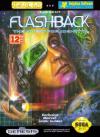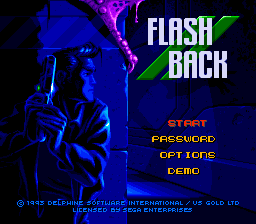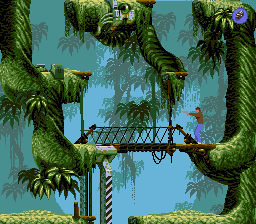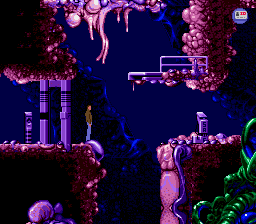Forum Links
Thread Information
Thread Actions
Order
Flashback
02-20-12 04:57 PM
 Totts is Offline
| ID: 544413 | 1302 Words
Totts is Offline
| ID: 544413 | 1302 Words
 Totts is Offline
Totts is Offline
| ID: 544413 | 1302 Words
Totts
Level: 96





POSTS: 1524/2427
POST EXP: 184908
LVL EXP: 8971478
CP: 16317.6
VIZ: 1546437

POSTS: 1524/2427
POST EXP: 184908
LVL EXP: 8971478
CP: 16317.6
VIZ: 1546437

Likes: 0 Dislikes: 0
Touted as a “CD-ROM Game on a Cartridgeâ€, Flashback: The Quest for Identity was one of the most graphically impressive Genesis games in its day. The game features fully hand-drawn backdrops and for its time remarkably fluid rotoscoped animation of walking, running and jumping movements, reminiscent of the earlier Prince of Persia. In addition to is beautiful graphics, Flashback has some of the most engrossing gameplay and puzzles that you will find on the Genesis.
The advent of the CD-ROM meant that developers could finally tell realistic stories with their games with real actors, real scr On the surface, Flashback doesn't seem much more than a Prince of Persia clone. Sure, you climb platforms, perform running jumps, hit switches, solve little puzzles to proceed - the usual stuff. Conrad actually controls quite a bit better than the old Prince ever did - pressing left or right makes Conrad walk in that direction (as opposed to running). If you need to jump on a higher ledge, you can just run towards it and Conrad will automatically leap up to it. Little tweaks in the old formula make Flashback much smoother than the game that inspired it. As opposed to sword fighting, you'll spend a lot of time blasting bad guys with your gun, which luckily has unlimited bullets. While some enemies can be killed by simply blasting away (or being quick on the draw), you'll need to define strategies to kill certain baddies. Early in the game, you get a bullet shield which will protect you from all projectiles for about a second. The key to winning many gunfights is using this shield at the right time to protect yourself then shoot the enemy when they're off guard. Thankfully, you can take four hits before perishing, unless you do something stupid like running into flames or standing still on electric floors. Of course, you WILL die, although you'll find plenty of save stations that act as checkpoints. The highly touted cinemas are almost entirely created with polygonal vector graphics, although the level of detail varies greatly. Every time you pick up an item, recharge your shield, or exchange money you're treated to a tiny scene. In between levels, though, they unravel a plot that pays homage to several great science fiction films. The game begins as Conrad is running away from someone, presumably bad, who is shooting at him. He escapes on a hoverbike, only to be shot down. Awakening in the jungle, Conrad realizes he has no idea what's going on - the only clue Conrad has is a holocube video of himself saying to visit his friend in a city known as New Washington. Luckily, New Washington is the second level, as it is beneath the crest of the planet Conrad is currently on. If you're too impatient, you can just read the plot in the Marvel comic that's included with the manual, although it only details the prologue. Conrad is actually a hotshot government agent, working on a pair of goggles that can "analyze molecular density". For all practical purposes, this lets him see that some humans are actually aliens in disguise who are attempting to gain control of the Earth government for undoubtedly nefarious reasons (a la "They Live", the classic movie with Rowdy Roddy Piper as the hero.) Of course, Conrad is kidnapped and brainwashed, but manages to escape, which is where the game begins. After deciphering what happened, Conrad swears to do everything he can to destroy the bad guys, dubbed "Morphs". This includes becoming a detective/bounty hunter to earn pocket change, participating in a survival game show called Deadly Tower, getting chased down by the Earth police force, and eventually transporting to the Morph's home planet. There are only seven levels in total, of wildly varying lengths. Unfortunately, you can't actually save your game - there are only passwords that let you skip between stages. This gets to be a particular pain in the second level, which is by far the longest in the game. Still, other than the occasionally wonky controls, those are really the only complaints that can be lodged against this classic. The Amiga, Genesis and PC disk versions were the first to the hit the market. While the Genesis version has slightly inferior graphics due to the limited color palette, it still manages to look quite good - the only real noticeable difference is in the detail of the sprites. Oddly enough, Conrad wears a white shirt in the Genesis version, and a rather bizarre magenta one in all of the other versions. The Genesis (and all of the other cartridge versions) also have annoying second-long load times between screens. The PC version switches screens instantly, and benefits from nicer graphics and smoother, extended cutscenes (most noticeable in the intro and trip to Earth.) It also has a weird option that zooms in on the action whenever Conrad kills anybody. It's meant to be cinematic but it's unnecessarily jarring and the characters are extremely pixellated anyway. The SNES version followed, which looks as nice as the PC version but runs the cutscenes a little bit slower than the Genesis version and also changes the name of the game show "Death Tower" into "Cyber Tower". The Jaguar version is the smoothest and probably the best of the cartridge releases. After bragging about that whole "CD game on a cartridge" bit, it's kind of a sellout that Flashback was actually released on CD, several times. The PC and 3DO releases are pretty much the same, adding in CG rendered cutscenes in place of the old polygonal ones. While the developers probably thought this was an enhancement, it really isn't - these cinemas are poorly modeled by today's standards and a lot of the "gee whiz" factor of the original game is lost entirely. Plus, accessing the cutscenes adds some unneeded load time, especially when you're just doing something simple, like picking up an item. Flashback was even released for the "multimedia entertainment system" Phillips CD-I, and suffers from some annoying bars on the side of the screen. The Sega CD release also contained these cutscenes, also they looked even worse due to the crappy color palette. To make up for it, the Sega CD version contains full voices all of the characters (as opposed to the other versions, which just have them in the cinemas) as well as a constantly running CD soundtrack. From the remixed version of the creepy title theme, to the tribal drums of the jungle music, the music really adds plenty of atmosphere to what was an otherwise silent game. While Flashback was released by US Gold in North America and Europe, it was distributed by Sunsoft in Japan. For some reason, the flesh colors of all of the enemies were changed to make them look less human - many of them now have green skin. Why this was done is uncertain - whether it be an artistic choice or some kind of weird censorship. There is a Japanese PC98 version, with heavily dithered graphics, but at a higher resolution. The advent of the CD-ROM meant that developers could finally tell realistic stories with their games with real actors, real scr On the surface, Flashback doesn't seem much more than a Prince of Persia clone. Sure, you climb platforms, perform running jumps, hit switches, solve little puzzles to proceed - the usual stuff. Conrad actually controls quite a bit better than the old Prince ever did - pressing left or right makes Conrad walk in that direction (as opposed to running). If you need to jump on a higher ledge, you can just run towards it and Conrad will automatically leap up to it. Little tweaks in the old formula make Flashback much smoother than the game that inspired it. As opposed to sword fighting, you'll spend a lot of time blasting bad guys with your gun, which luckily has unlimited bullets. While some enemies can be killed by simply blasting away (or being quick on the draw), you'll need to define strategies to kill certain baddies. Early in the game, you get a bullet shield which will protect you from all projectiles for about a second. The key to winning many gunfights is using this shield at the right time to protect yourself then shoot the enemy when they're off guard. Thankfully, you can take four hits before perishing, unless you do something stupid like running into flames or standing still on electric floors. Of course, you WILL die, although you'll find plenty of save stations that act as checkpoints. The highly touted cinemas are almost entirely created with polygonal vector graphics, although the level of detail varies greatly. Every time you pick up an item, recharge your shield, or exchange money you're treated to a tiny scene. In between levels, though, they unravel a plot that pays homage to several great science fiction films. The game begins as Conrad is running away from someone, presumably bad, who is shooting at him. He escapes on a hoverbike, only to be shot down. Awakening in the jungle, Conrad realizes he has no idea what's going on - the only clue Conrad has is a holocube video of himself saying to visit his friend in a city known as New Washington. Luckily, New Washington is the second level, as it is beneath the crest of the planet Conrad is currently on. If you're too impatient, you can just read the plot in the Marvel comic that's included with the manual, although it only details the prologue. Conrad is actually a hotshot government agent, working on a pair of goggles that can "analyze molecular density". For all practical purposes, this lets him see that some humans are actually aliens in disguise who are attempting to gain control of the Earth government for undoubtedly nefarious reasons (a la "They Live", the classic movie with Rowdy Roddy Piper as the hero.) Of course, Conrad is kidnapped and brainwashed, but manages to escape, which is where the game begins. After deciphering what happened, Conrad swears to do everything he can to destroy the bad guys, dubbed "Morphs". This includes becoming a detective/bounty hunter to earn pocket change, participating in a survival game show called Deadly Tower, getting chased down by the Earth police force, and eventually transporting to the Morph's home planet. There are only seven levels in total, of wildly varying lengths. Unfortunately, you can't actually save your game - there are only passwords that let you skip between stages. This gets to be a particular pain in the second level, which is by far the longest in the game. Still, other than the occasionally wonky controls, those are really the only complaints that can be lodged against this classic. The Amiga, Genesis and PC disk versions were the first to the hit the market. While the Genesis version has slightly inferior graphics due to the limited color palette, it still manages to look quite good - the only real noticeable difference is in the detail of the sprites. Oddly enough, Conrad wears a white shirt in the Genesis version, and a rather bizarre magenta one in all of the other versions. The Genesis (and all of the other cartridge versions) also have annoying second-long load times between screens. The PC version switches screens instantly, and benefits from nicer graphics and smoother, extended cutscenes (most noticeable in the intro and trip to Earth.) It also has a weird option that zooms in on the action whenever Conrad kills anybody. It's meant to be cinematic but it's unnecessarily jarring and the characters are extremely pixellated anyway. The SNES version followed, which looks as nice as the PC version but runs the cutscenes a little bit slower than the Genesis version and also changes the name of the game show "Death Tower" into "Cyber Tower". The Jaguar version is the smoothest and probably the best of the cartridge releases. After bragging about that whole "CD game on a cartridge" bit, it's kind of a sellout that Flashback was actually released on CD, several times. The PC and 3DO releases are pretty much the same, adding in CG rendered cutscenes in place of the old polygonal ones. While the developers probably thought this was an enhancement, it really isn't - these cinemas are poorly modeled by today's standards and a lot of the "gee whiz" factor of the original game is lost entirely. Plus, accessing the cutscenes adds some unneeded load time, especially when you're just doing something simple, like picking up an item. Flashback was even released for the "multimedia entertainment system" Phillips CD-I, and suffers from some annoying bars on the side of the screen. The Sega CD release also contained these cutscenes, also they looked even worse due to the crappy color palette. To make up for it, the Sega CD version contains full voices all of the characters (as opposed to the other versions, which just have them in the cinemas) as well as a constantly running CD soundtrack. From the remixed version of the creepy title theme, to the tribal drums of the jungle music, the music really adds plenty of atmosphere to what was an otherwise silent game. While Flashback was released by US Gold in North America and Europe, it was distributed by Sunsoft in Japan. For some reason, the flesh colors of all of the enemies were changed to make them look less human - many of them now have green skin. Why this was done is uncertain - whether it be an artistic choice or some kind of weird censorship. There is a Japanese PC98 version, with heavily dithered graphics, but at a higher resolution. |
Member
Affected by 'Laziness Syndrome'
Registered: 08-23-10
Location:
Last Post: 3264 days
Last Active: 2698 days
Affected by 'Laziness Syndrome'
Registered: 08-23-10
Location:
Last Post: 3264 days
Last Active: 2698 days
Page Comments
This page has no comments


 User Notice
User Notice 



